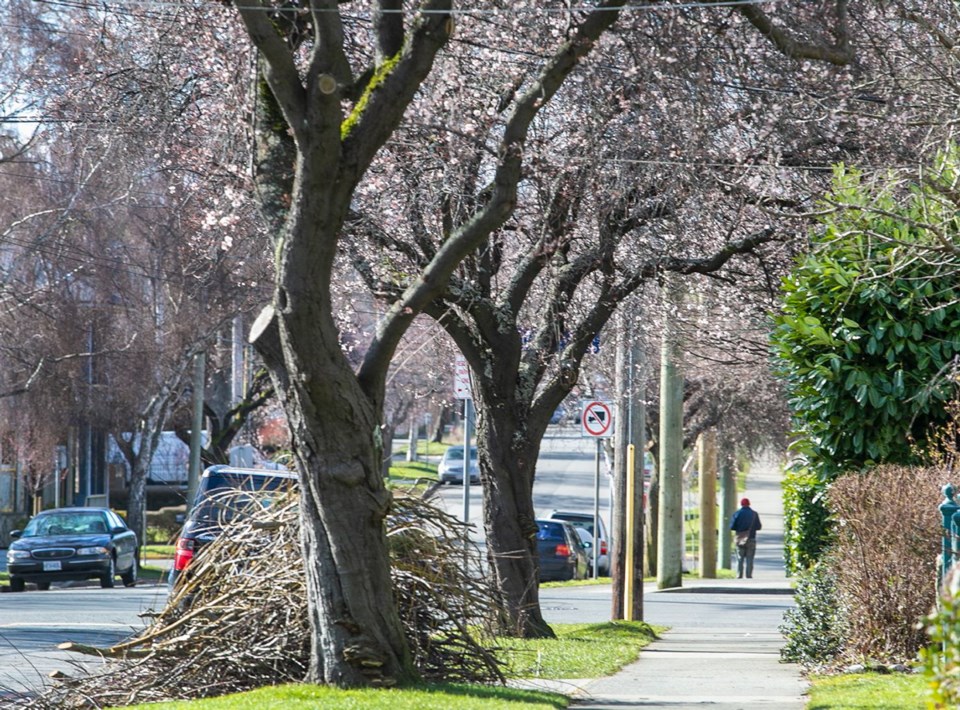Victoria’s cherry blossom trees, which bathe city streets in pink in late winter and spring, are safe. That’s the message Victoria’s mayor and two councillors are trying to send amid worries that it is becoming city practice to replace ailing cherry blossom trees with less colourful native trees.
Councillors Jeremy Loveday and Laurel Collins have proposed a motion to recognize “the historic importance and symbolic significance of cherry blossom trees.” They want city staff “to report back with options for maintaining an ongoing presence of cherry trees.”
The two councillors also want Mayor Lisa Helps to “write to the Victoria Nikkei Cultural Society to express appreciation for the Japanese community’s historic gift [of the trees] and clarify the city’s policy regarding cherry blossom trees.”
In an interview on Tuesday, Helps said: “There’s been no council decision to systematically remove cherry trees. There’s no mistake about the fact that these are highly valued public assets.”
The issue came to prominence after councillors approved additional funding for the city’s tree management program, and Coun. Geoff Young said that one consequence could be the loss of cherry blossom trees.
Young cited the example of an aging ornamental blossom tree on Oxford Street that was replaced with a native tree, and said the same thing has happened on other streets.
“I have observed on a lot of streets the new trees that have gone in have not been replacements of the blossoming trees,” Young said.
“A long-standing concern has been the lack of consideration of the possibility of retaining these blossom-filled streets,” he said, saying residents on such streets should be consulted.
Young expressed concern that with more funds to identify trees in danger of failure, more cherry blossom trees could be removed.
Helps said the city has a policy to replace non-native plants with native plants — annuals and perennials — but it doesn’t apply to trees. However, Young is concerned it’s happening “on the ground” anyway.
But Helps insisted: “Cherry trees will be replaced by cherry trees where possible.”
“We are investing $850,000 this year and every year forward to maintain and enhance the urban forest because that’s what our residents have been asking for, and somehow that turns into a story that we are clear-cutting cherry trees,” she said.
“There’s something really bizarre going on.”
Tsugio Kurushima, president of the Victoria Nikkei Cultural Society, said the Japanese society has received several calls since from citizens upset that cherry blossom trees could be replaced with native trees.
It is asking civic politicians to consider the cultural significance of the trees, he said. “There’s a historical connection.”
The trees were given to the city in 1937 after the Japanese community’s cherry blossom float won first place in a parade for the 75th anniversary of the city’s incorporation. They were planted in James Bay and Fairfield.
“It was a gesture from the immigrant community to thank Victoria and Canada for allowing us to start a new life in Canada,” Kurushima said.
“We do view ourselves as the keepers of that heritage tradition,” he said. “Notwithstanding that, I think Victoria would be the losers if we did not have those blossoming cherries. They are beautiful. They are an iconic part of the city, they attract tourists and they bring people joy.”
Helps said if a cherry tree in the city dies, it will be replaced with another ornamental cherry or plum, unless the city’s arbourists believe another won’t survive long term.
“We are experiencing the effects of climate change,” she said. “And trees native and non-native, but particularly non-native, are experiencing extra stress from the hot dry summers and we have a responsibility when trees are stressed or diseased to remove them.
“We need to be realistic that we are in a climate crisis and our staff know and council knows the importance of the cherry trees,” she said, adding: “This notion that we’ll never ever plant another cherry tree is absolutely false.”
In 2017, the city planted 20 ornamental flowering cherries and 20 ornamental flowering plums, Helps said. “We know that the blossoms are key to who we are as Victorians. It’s a matter of planting the right tree in the right place at the right time.”
University of Victoria professor Patrick von Aderkas, with the Centre for Forest Biology, has studied climate change in relation to native plant species.
There might be confusion among city councillors — cherry blossom trees are dying because they are old, not because of climate change, he said.
“Ornamental cherry and plum species have large natural distributions in Asia that show excellent adaptations to a broad range of climates,” von Aderkas said. “The only recent studies on climate change and cherries point to the fact that they are flowering earlier. No scientist is saying that they are threatened.”
He said the cherry trees are low-maintenance, tough urban trees that are able to weather wind, ice and snow without breaking.



